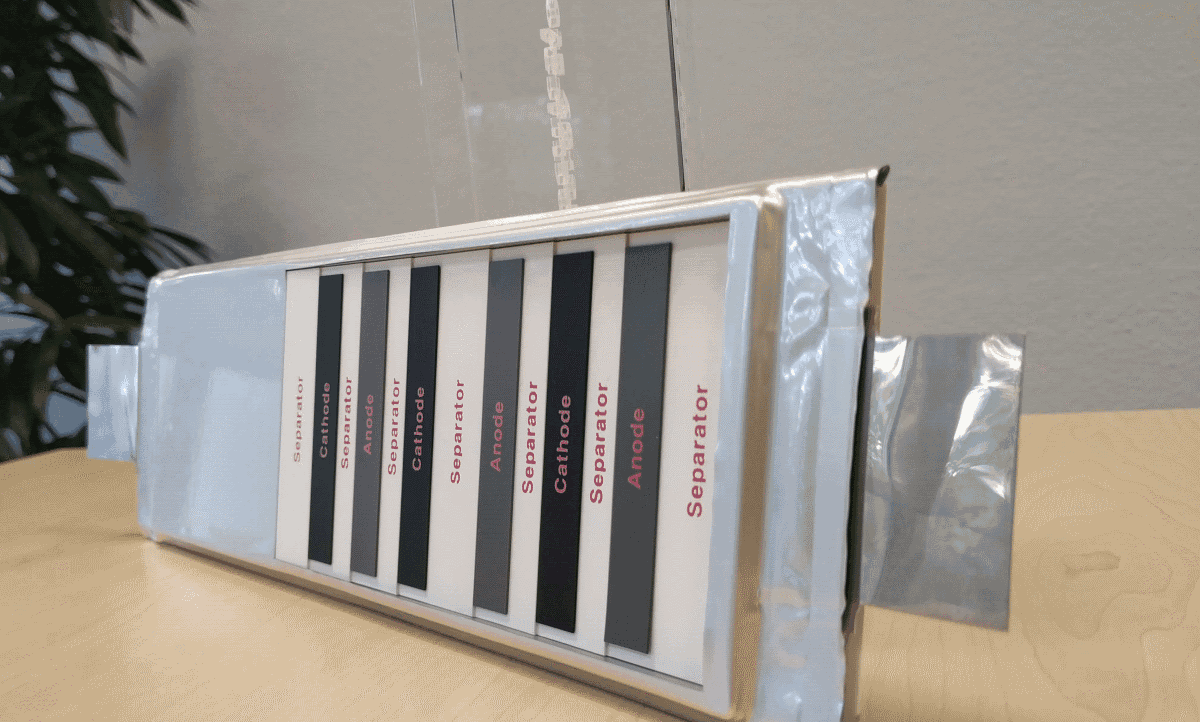In the past months, we often saw questions about whether NCM (Lithium Nickel Manganese Cobalt Oxide) is the best material for being used as cathode material for our batteries. We saw questions about performance, safety and sustainability, sometimes even resulting in recommendations to rather use LFP (Lithium Iron Phosphate) for residential as well as commercial batteries. In this article, we would like to explain why NCM is the right choice of cathode material for LG Energy Solution batteries and why LFP based batteries should not be preferred compared over NCM batteries. We will explain, why our NCM battery technology is more durable, less heavy, better to manage and more environmental friendly.
We will cover these topics:
- NCM and LFP
- Li-ion Battery Market Trend
- NCM vs. LFP Comparison
- Energy required to produce NCM vs. LFP Battery
- Advantages of using LG Energy Solution’s NMC technology
- Conclusion
NCM and LFP
A Li-ion Battery is composed of four main parts: cathode, anode, electrolyte and separator.
The Battery type is usually named after its cathode materials such as NCM battery or LFP battery.
NCM is composed of Lithium, Nickel, Cobalt and Manganese while LFP is made up of Lithium, Iron and Phosphate.
Li-ion Battery Market Trend
Due to its quality uniformity and high energy density, NCM batteries have become the most widely used component in the battery industry in total.
Within the world market for batteries, the Li-ion Battery market expands its production capacity centered on NCM battery. According to Bloomberg New Energy Finance, NCM battery production capacity takes up 69% of the entire Li-ion battery production capacity.
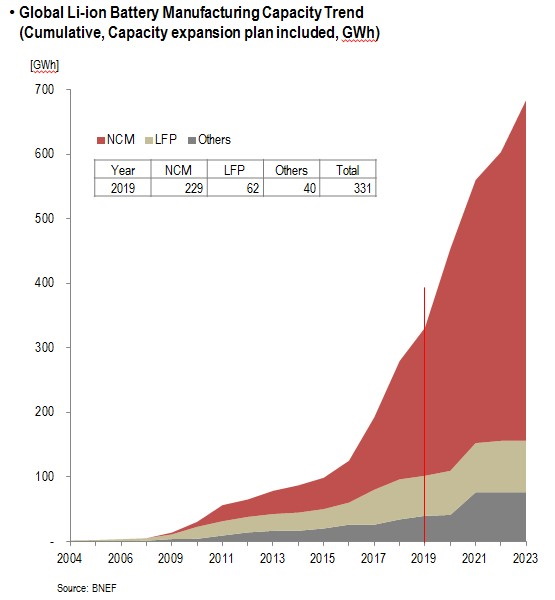
In the EV (Electric Vehicle) battery industry, while LFP battery adoption rate decreases, NCM battery adoption rate constantly increases and therefore, NCM battery adoption rate is expected to increase from 53% in 2019 to 64% in 2025.
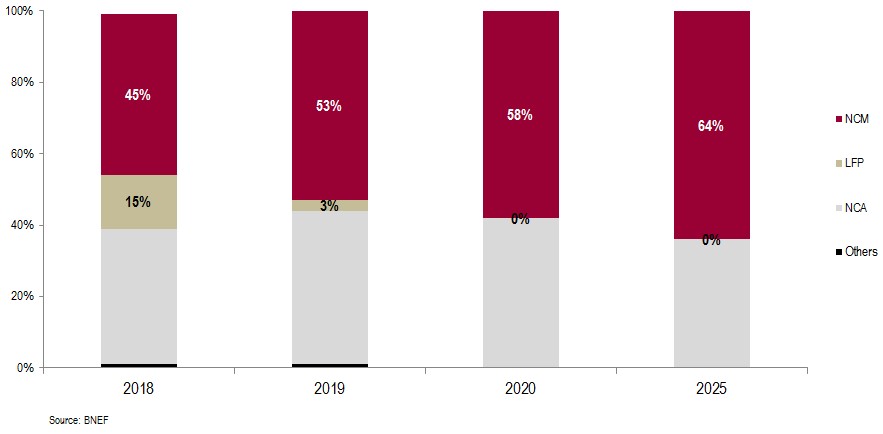
NCM vs. LFP Comparison
Lithium diffusion coefficient, electron mobility
NCM battery features higher power rating and energy density compared to LFP battery due to its higher lithium diffusion rate and electron mobility.
While NCM’s lithium-ions can move in two different directions, LFP’s lithium-ions can only move in in one single direction.
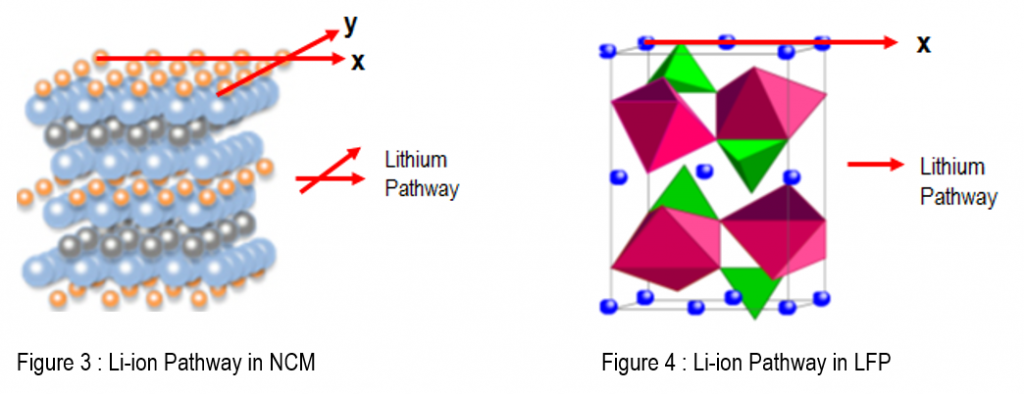
As a result, according to a journal published in 20101) by scholars in the Department of Mechanical Engineering at the University of Michigan, NCM’s lithium diffusion coefficient is 10,000 times faster than that of LFP; in case of electron mobility, NCM is 1,000 times faster than LFP.

When lithium and electron mobility are faster, a battery can realize higher power rating and higher energy density.
Hygroscopicity
Because LFP absorbs moisture from the air more easily than NCM, LFP requires a strict humidity control during its production process. If the humidity is not well controlled, the water content in LFP battery increases which causes side reactions during its charge-discharge process. These side reactions result in a faster decrease in performance of the battery. Furthermore, water hinders the battery to form a Solid Electrolyte Interface (SEI) layer which once again contributes to the faster decrease in performance of its battery.
According to a paper published in 20132), when LFP and NCM electrodes are exposed to 40% Relative Humidity (RH), water content in NCM electrode keeps below 750ppm while LFP electrode increases to more than twice within in an hour.

The paper also compares how the different water content in a battery influences the battery’s capacity. When the battery’s water content increases from 1300ppm to 1800ppm (38% increase), the battery capacity decreases by approximately 10%.
As a summary, an increased water content can be considered as an increase in impurity; higher impurity leads to a higher resistance – higher chance to cause a cell swelling (electrolyte gasification) issue.
Charge-Discharge Curve
Let’s now compare the charge-discharge curves of NCM and LFP batteries : NCM battery’s State-of-Charge (SOC) varies distinctly by its voltage level. On the other hand, LFP battery’s SOC level cannot be easily distinguished by its voltage level due to its flat charge-discharge curve. As a result, accurate SOC diagnosis is possible for NCM batteries while the SOC accuracy for LFP batteries is very challenging.
LG Energy Solution’s internal analysis found that the SOC estimation for NCM battery deviates within 1~2% of its actual value while LFP battery deviates around 10%. If an accurate SOC calculation is not possible, the probability to operate the battery out of the desired range is higher, resulting in higher performance degradation.

As shown in the graph above, the upper voltage limit for NCM is around 4.2V while LFP is around 3.5V. If the capacities of the batteries remain constant, the energy content is defined by the voltage, which turns the NCM battery to a higher energy battery compared to a LFP battery.

Discharge Capacity, Capacity Retention
A NCM battery with a thinner cathode can have same discharging capacity as a LFP battery with a thicker cathode. Furthermore, NCM battery has higher capacity retention than LFP battery at same number of cycles.
Based on a paper published in 20123), the same discharge capacity of 1.7mA/cm2 requires 1.5 times thicker electrode (77μm) for LFP batteries compared to NCM battery (50 μm). This means that a LFP battery uses more cathode material than a NCM battery to realize the same battery capacity. Therefore, LFP Batteries with more kg of cathode materials being loaded on its electrode creates more material to be recycled at the end of its life, causing a greater impact onto its environment.
When comparing NCM & LFP batteries of the same discharge capacity (2.6mA/cm2) after 500 cycles the NCM battery maintains 15% more capacity (80%) than the LFP battery (65%).
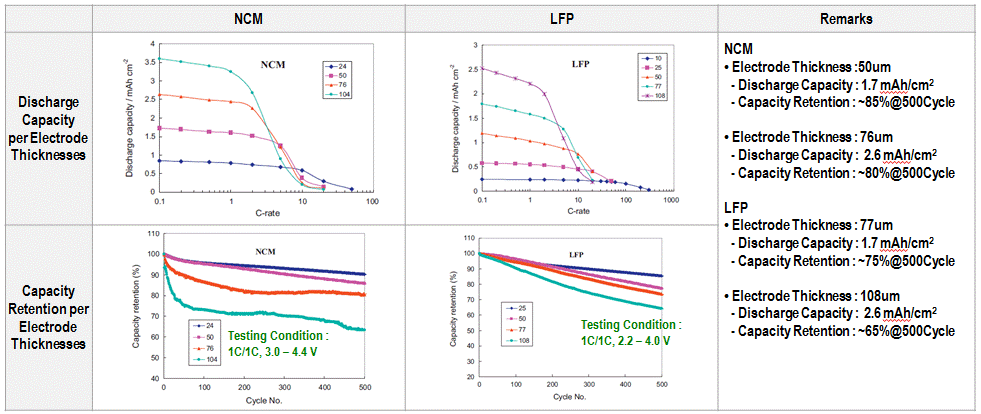
Another paper published in 20144) shows that NCM batteries can operate for a longer period of time before reaching the same retention rate of its initial capacity when compared to LFP batteries.
The paper shows that a LFP battery reaches 80% of its initial capacity at 377 cycles, while a NCM battery maintains 80% of its initial capacity after 455 cycles. While a NCM battery maintains ~75% of its initial capacity after 700 cycles, a LFP battery reaches ~20% of its initial capacity after 700 cycles.
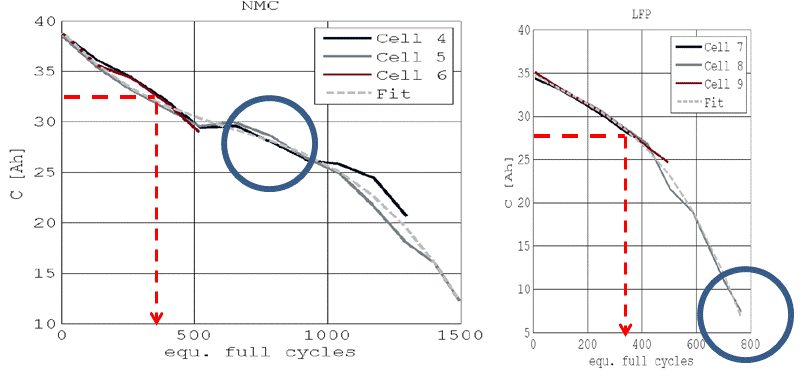
The LFP manufacturer’s argument that LFP batteries have a higher capacity retention than NCM batteries doesn’t align with the results from two research papers mentioned above.
Resistance
When monitoring the battery resistance as cycles proceed, a NCM battery maintains lower level of resistance compared to a LFP battery. Lower resistance allows batteries to perform according to their designed capacity at lower lost.
If you take a look at the paper published in 20144), LFP battery’s resistance increases to 3 Ohms shortly after 500 cycles while NCM battery’s resistance remains under 3 Ohms even after 1,000 cycles.
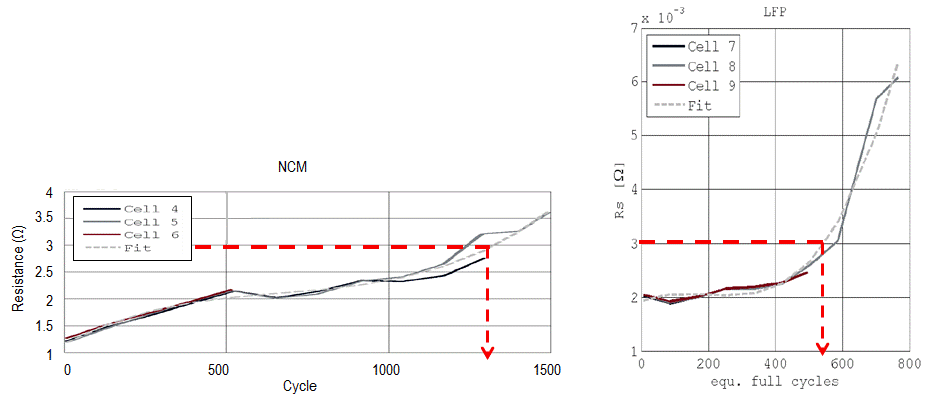
Degradation in performance of a battery increases dramatically as its resistance increases, and therefore, a NCM battery performs better than a LFP battery as cycles proceed.
Energy required to produce NCM vs. LFP Battery
A NCM battery might require more energy during production based on weight. However, since the capacity of a battery is the relevant characteristic, the energy per kWh needs to be compared: a NCM battery requires very similar amount of energy compared to a LFP battery during its manufacturing process.
If you look at the paper published by the scholars from Argonne National Laboratory found in 20155), to produce 28kWh EV Battery, LFP battery requires 100 cells while NCM requires only 96 cells. As a consequence, a LFP battery requires a higher quantity of battery cells to produce the same capacity of EV battery compared to a NCM battery, resulting in more waste at the end of its life.
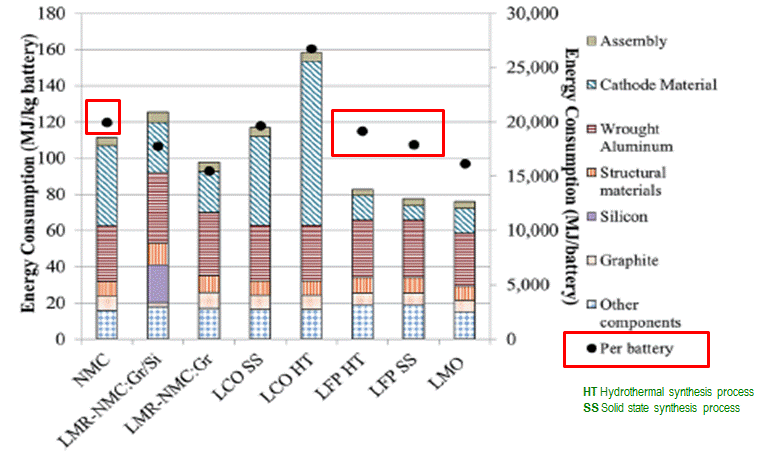
LFP battery makers insist that a LFP battery requires less amount of energy to be produced compared to a NCM battery, exercising lesser impact onto its environment. However, when comparing batteries with same capacities, energy required to produce the LFP and NCM batteries do not vary much. We want to highlight that in order to produce the same kWh of battery, LFP requires more number of cells than NCM and therefore, LFP manufacturers produce more waste to the environment. In addition, since LFP is composed of cheap metal, Iron, recycling companies are reluctant to recollect and recycle LFP battery due to low economic viability.
Advantages of using LG Energy Solution’s NMC technology
Patency
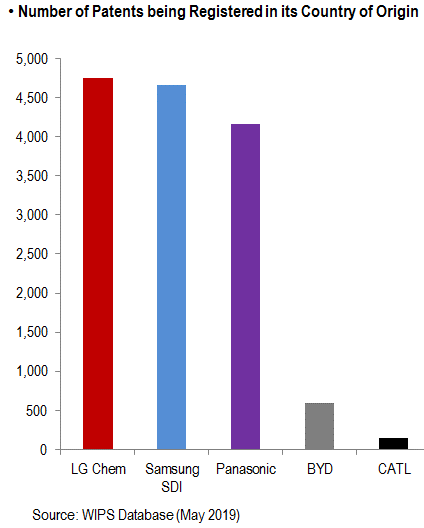
LG Energy Solution produces NCM ESS batteries. LG Energy Solution is holding the largest number of registered patency with regards to battery technologies in the industry (as of May 2019). In general, NCM technology has received significantly higher research attention compared to other technologies and is better understood.
Lamination & Stacking vs. Winding Process
LG Energy Solution uses Lamination & Stacking manufacturing process to produce batteries. Lamination & Stacking process stacks cathodes, anodes and separators vertically to assemble a battery. On the other hand, Winding process rolls cathodes, anodes and separators in an oval shape to assemble a battery. Lamination & Stacking process can realize higher electrode loading through effective space utilization – less dead space in a battery cell – and higher dimensional stability.
Within the stack of electrodes, LG Energy Solution inserts separators with its proprietary “SRS” technology applied – nanoparticle coated on separators which grant a higher puncture resistance.
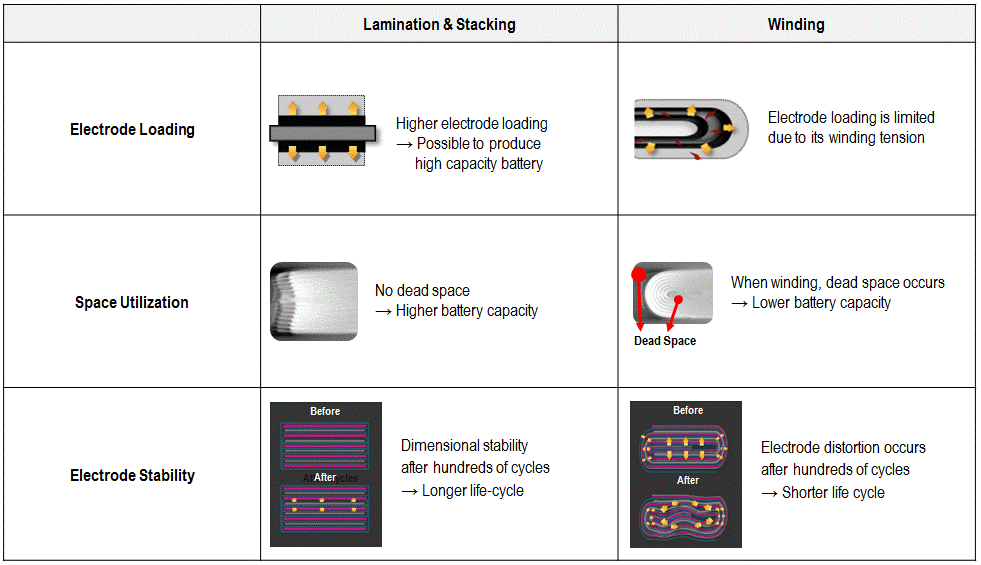
Safety
A simple statement of “NCM batteries are safer than LFP batteries (or vice versa)” is not possible because the question of battery safety includes many aspects like manufacturing quality, material purity, electrical contact quality, environmental factors, appropriate battery protection (BMS), etc. The question of safety by far cannot be reduced to the cathode material. This why LG Energy Solution has been viewing this matter holistically and assures highest quality on all manufacturing and operational aspects. The largest international car manufacturers have tested LG Energy Solution batteries under the worst possible stress conditions and they have accepted LG Energy Solution batteries as safe for usage in their automotive products.
LG Energy Solution’s residential ESS product’s safety is verified internationally through achieving six different safety certificates.
1) EMC (Electromagnetic Test)
2) IEC 62619 (Operational Safety : Cell, Module, System)
3) UL1642 (Standard for Lithium Batteries)
4) UL1973 (Standards for Batteries for Use in Stationary, Vehicle Auxiliary Power and Light Electric Rail Applications)
5) TUV JIS (Japanese standard for ESS Battery)
6) UN38.3 (Transportation Testing for Lithium-ion Batteries)
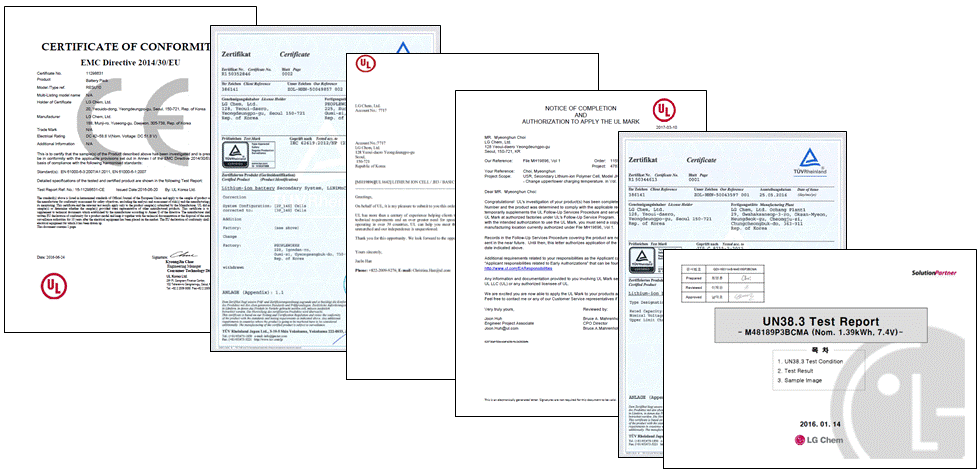
Responsible Sourcing
LG Energy Solution monitors value chain of the raw materials it is using to realize responsible sourcing. In particular, LG Energy Solution highlights the importance of responsible souring of cobalt being used in its NCM battery.
Primarily, LG Energy Solution keeps the value chain of its cobalt transparent. LG Energy Solution monitors entire sourcing processes of cobalt and performs a third-party audit of its suppliers to strengthen the transparency.

As a second track, LG Energy Solution also endeavors to reduce the content of cobalt in its battery. So far, it has succeeded to reduce the weight portion of cobalt in a battery by 35%.
Furthermore, LG Energy Solution is working to end child labor in cobalt mines. LG Energy Solution has partnered with a number of NGOs to focus on the DRC particularly.
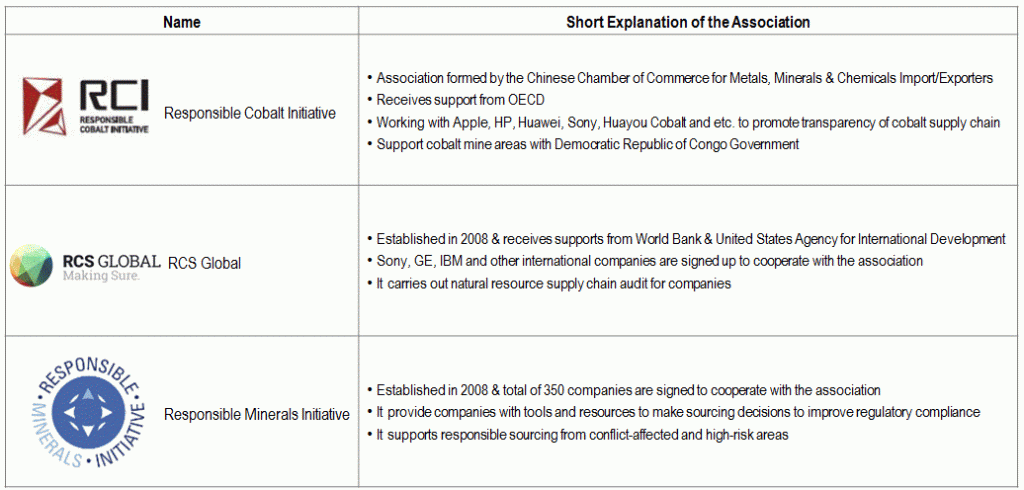
There’s absolutely no excuse for anyone under legal working age to be in our supply chain.
We know there are real challenges with artisanal mining of cobalt, but walking away from it indefinitely would be harmful to communities who rely on this mining for their income
LG Energy Solution is working to end child labor and human rights abuses in mining communities.
LFP battery manufacturers insist that cobalt used in NCM are sourced inappropriately by exploiting child labors to mine the cobalt. However, LG Energy Solution cooperates with third parties such as RCI, RCs Global and etc to monitor & improve the transparency of the cobalt value chain and realize responsible sourcing.
Green Company
LG Energy Solution has installed 3MWh of PV farm at its Ochang manufacturing site, producing 4.2GWh of renewable energy annually. Through generating clean energy, LG Energy Solution puts its effort to become a green company.
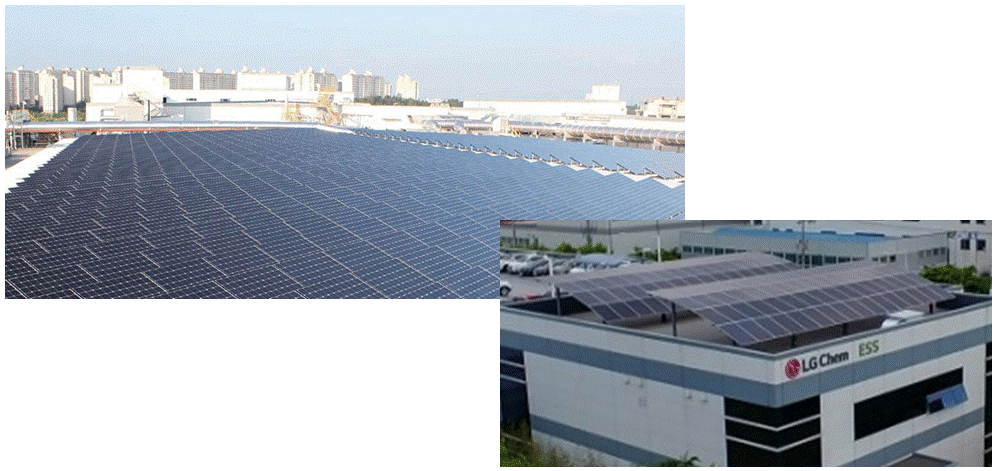
LG Energy Solution also dives into the issue of batteries to be discarded at the end of its life. To minimize the environmental impact of our product, LG Energy Solution endeavors to make a closed loop circle through cooperating with various local recycling companies.

Through contracting selected recycling companies, LG Energy Solution is assuring the most sustainable recycling processed for their used batteries. Local recycling companies process used LG Energy Solution batteries and recover Nickel, Cobalt and Manganese within their recycling process. This is important for assuring a closed loop material cycle process and avoiding the waste of rare materials.
Conclusion
In conclusion, we would like to summarize that NCM battery technology has very significant advantages and should be seen as a prime choice in the rechargeable battery world. There is no justified reason, why NCM material should be excluded from a selection of preferred materials.
- NCM technology is enabling the highest energy storage density for rechargeable batteries
- Industrial NCM batteries feature among the higher cycle life compared to other cathode materials
- The energy required to manufacture NCM batteries does not require significantly more amount of energy compared to LFP batteries.
- Raw material sourcing for manufacturing LG Energy Solution batteries is thoroughly audited and tracked in order to avoid the usage of materials from questionable sources. LG Energy Solution is actively fighting against child labor.
- Through close relationships with recycling companies, LG Energy Solution is trying to realize a closed loop recycling process for its batteries.
References
1) M. Park et al., A review of conduction phenomena in Li-ion batteries, Journal of Power Sources, 7904 (2010) ↩
2) U. Langklotz et al., Water Uptake of Tape-Cast Cathodes for Lithium Ion Batteries, Journal of Ceramic Science and Technology, Journal of Ceramic Science and Technology, 69-29 (2013) ↩
3) H. Zheng et al., A comprehensive understanding of electrode thickness effects on the electrochemical performances of Li-ion battery cathodes, Electrochimica Acta 71, 258-265 (2012) ↩
4) H. Popp et al., Lifetime analysis of four different lithium ion batteries for (plug – in) electric vehicle, Transport Research Arena (2014) ↩
5) J. B. Dunn et al., The significance of Li-ion batteries in electric vehicle life-cycle energy and emissions and recycling’s role in its reduction, Energy Environ. Sci. 158 (2015) ↩

